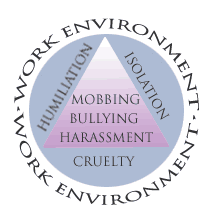MOBBING by Susan Rae Sampson (Susan Rae Sampson, WSTLA EAGLE member is with Sampson & Wilson, Inc., P.S., in Renton, Washington. Ms. Samspon is a Ninth Congressional District Representative on the WSTLA Board of Governors.) Every employment lawyer has heard the complaint, “They brought in a new manager and he is trying to get rid of me. I have never been written up for anything! My sales statistics are as good as anybody else’s, but all of a sudden I can’t do anything right. I went to Human Resources, and they just acted like I’d done something wrong, and put me on this schedule for weekly meetings with my supervisor. I used to love my job, but I can hardly stand going there any more. My doctor gave me a prescription for Paxil…” And every employment lawyer has had to reply, one time or another, “You are an employee at will. They can let you go for any reason, or no reason at all, except for the illegal reasons, and none of the illegal reasons seem to apply in your case: you have no contract, no collective bargaining agreement. You aren’t a whistleblower who has gone to the government with complaints of illegal activity, and you haven’t complained to L&I about an injury, or about safety or wage and hour issues. Nothing suggests that you are the victim of discrimination on the basis of age over 40, race, sex, ancestry, creed, marital status, or disability. There is nothing I can do to help.”
“But this is a hostile working environment!” And so it is, but it isn’t necessarily against the law. To management, it is “progressive discipline”: every act of the employee that could possibly be treated as malfeasance, misfeasance or nonfeasance is documented and treated as cumulative. To the employee, it is unfair, demoralizing and counterproductive, but except for “hostile working environment,” employees have not had a single word like “discrimination” to express the concept. Now several writers have put a name on the concept, and have called it “mobbing.” The lead commentator was Dr. Heinz Leymann, who conducted extensive studies in Scandinavia and who published studies descriptive of the “mobbing” process. In the United States, Dr. Noa Zanolli Davenport and two colleagues, have published “Mobbing, Emotional Abuse in the American Workplace,” copyright 1999, Civil Publishing Society, Ames, Iowa. Dr. Davenport has become an expert witness in the identification of “mobbing.” And Dr.Kenneth Westhues, a Canadian professor, was astonished to find himself in a role that had changed from “mobber” to “mobbee.” He recounts his experiences from home, where he sits on paid administrative leave while the relevant committees run through their processes of firing him. He tells it all, with humor, in “Eliminating Professors, A Guide to the Dismissal Process,” copyright 1998 Kempner Collegium Publications, Queenston, Ontario. His prototypical professor who is being eliminated is Dr. “PITA,” the “Pain in the Ass,” who has become the victim of his employer’s efforts to justify the termination of his employment. Until “mobbing” is against the law, legal help for its victims remains somewhat collateral, off point-unions may assist, discrimination laws may have limited applicability-but some institutions are beginning to recognize and address “mobbing.” In Europe, the Swedish National board of Occupational Safety and Health has published a booklet on creating a psychologically safe environment. In the U.S., such corporations as Levi Strauss and Saturn have implemented programs for assessing the risks of mobbing, of expressing mission statements intended to reduce incidents of mobbing, and of behaving proactively to avoid the circumstances allowing mobbing to arise. Perhaps some of these statements will become enforceable promises to the employee, but until then, the employment lawyer may be constrained to saying “I understand; you aren’t alone, and here are some books to read about what’s going on; but it still isn’t against the law.”





